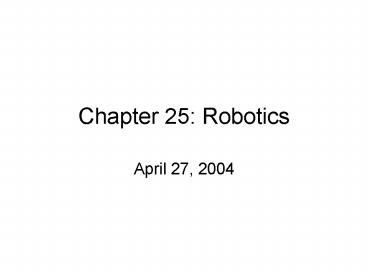Chapter 25: Robotics - PowerPoint PPT Presentation
1 / 21
Title:
Chapter 25: Robotics
Description:
Thursday: Jeff Elser's presentation, general discussion. Friday: Rafal Angryk ... Difficult to change behavior (wasp) Three Layer Architecture. Very common today ... – PowerPoint PPT presentation
Number of Views:240
Avg rating:3.0/5.0
Title: Chapter 25: Robotics
1
Chapter 25 Robotics
- April 27, 2004
2
The Week Ahead
- Wednesday Dmitrii Zagorodnov
- Thursday Jeff Elsers presentation, general
discussion - Friday Rafal Angryk
- Monday CS 536 final _at_ 2 p.m.
3
25.1 Introduction
- Robot Components
- Sensors
- Effectors
- Processors
- Robot Types
- Manipulators (gt 1 million worldwide)
- Mobile (ULV and planetary, UAV, AUV)
- Hybrid
- Other (prosthetic devices, multibody systems)
4
Typical Environments
- Partially Observable
- Stochastic
- Dynamic
- Continuous
5
25.2 Robot Hardware
- Sensors
- passive (e.g. camera)
- active (e.g. sonar, laser, radar)
- Record distances, Figure 25.2
- Record images
- Record properties of robot (propriocaptive), e.g.
inertial sensors
6
Effectors
- Degrees of Freedom (DOF), e.g. a wrist has 3 DOF
- A car has 2 controllable DOF but 3 effective DOF
- A non-holonomic robot has a higher effective DOF
than controllable DOF
7
Effectors
- Most robot arms are holonomic (simpler)
- Most mobile robots are non-holonomic
- Prismatic joints allow sliding motion
- Revolute joints allow rotational motion
- Dynamic stability vs. Static stability
- Power Sources electric motor, pneumatic
actuator, hydraulic actuator
8
25.7 Robotic Software Architecture
- Subsumption Architecture, Rodney Brooks, 1986
- Application wall following
- a framework to assemble reactive (as opposed to
deliberative) controllers out of FSAs. - Figure 25.22
- Difficult to understand
- Difficult to change behavior (wasp)
9
Three Layer Architecture
- Very common today
- Reactive Layer (sense-act loop)
- Executive Layer
- Deliberative Layer
10
Robotic Programming Languages
- General Robot Language, GRL, 2000
- function
- uses FSMs as building blocks
- provides communication and control constructs
- C Embedded Systems, CES, 2000
- integrates probability and learning
11
Robotic Programming Languages
- Reactive Action Plan System, RAPS, 1994
- can specify goals, plans, conditions for likely
plan success - ALisp, 2002
- can program non-deterministic choice points
- learns via reinforcement learning
12
25.8 Application Domains
- Industry
- Agriculture
- Transportation, Figure 25.23, the challenge is to
use natural cues to locate robot - Hazardous Environments
- Exploration, Figure 25.24
- Health Care, Figure 25.23
- Personal Service
- Entertainment, Figure 25.4b
- Human Augmentation
13
25.4 Planning to Move
- Assume
- motions are deterministic
- localization is exact
- Point to point motion
- Compliant motion
- Configuration space includes location,
orientation, joint angles
14
Path Planning
- Involves continuous spaces
- Two common techniques that map the continuous
space onto a discrete space - cell decomposition
- skeletonization
15
Configuration Space
- A workspace representation is easier. For
example, in Figure 25.12(a) everything can be
specified by (xe, ye) and (xs, ys) - The problem is that not all points are realizable
16
Configuration Space
- Use (?e, ?s), the angles of the joints
- Kinematics Maps a configuration space onto a
workspace (easy) - Inverse Kinematics Maps a workspace onto a
configuration space - Obstacles, Figure 25.12b
- Free Space vs. Occupied Space, Figure 25.13
17
Cell Decomposition
- Figure 25.14
- Each region can be solved simply
- Rectangles
- hard for high dimensions
- mixed cells are challenging (dont want unsound
solutions or incomplete problem solving ability) - Irregular Shapes
- Potential Field, Figure 25.15
18
Skeletonization
- Reduce the robots free space to 1-D
- Voronoi Graphs, Figure 25.16a
- Map the initial point onto the Voronoi Graph
- Follow Voronoi Graph
- Map point on Voronoi Graph onto goal point
- Probabilistic Roadmaps, Figure 25.16b
- Offers more routes than Voronoi Graphs
19
Exercise 25.8
- Humans are so adept at basic tasks such as
picking up cups or stacking blocks that they
often forget how complex these tasks are. In
this exercise, you will discover the complexity
and recapitulate the last 30 years of
developments in robotics. First, pick a task,
such as building an arch out of three blocks.
Then, build a robot out of four humans as follows
20
Exercise 25.8
- Brain. The job of the Brain is to come up with a
plan to achieve the goal and to direct the hands
in the execution of the plan. The Brain receives
input from the Eyes, but cannot see the scene
directly. The brain is the only one who knows
what the goals is. - Eyes. The Eyes job is to report a brief
description of the scene to the Brain. The Eyes
should stand a few feet away from the working
environment, and can provide qualitative
descriptions or quantitative descriptions. Eyes
can also answer questions from the Brain.
21
Exercise 25.8
- Left Hand and Right Hand. One person plays each
Hand. The two Hands stand next to each other
the Left Hand uses only his or her left hand, and
the Right Hand only his or her right hand. The
Hands execute only simple commands from the Brain
for example, Left Hand, move two inches
forward. They cannot execute commands other
than motions for example, Pick up the box is
not something a Hand can do. The Hands must be
blindfolded. The only sensory capability they
have is the ability to tell when their path is
blocked by an immovable obstacle such as a table
or the other Hand. In such cases, they can beep
to inform the Brain of the difficulty.































